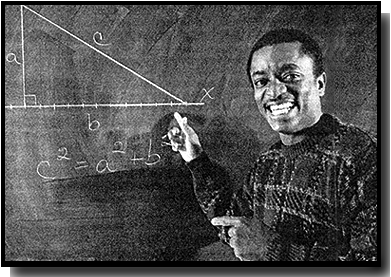| ACCESSIBLE ARITHMETIC | ||||||||
| Making math add up by reaching kids through cable | ||||||||
|
By Tamara Henty USA TODAY In a Mr. Rogers-type cardigan and matching demeanor, Terry Caliste makes the Pythagorean theorem seem as easy as, well, making a peanut butter-and-jelly sanwich. "We got three sides," says the host of an increasingly popular cable TV show in New Jersey. "We know that one side is perpendicular to the other. We know that, because they form a right angle. You tell me the length of any two sides and I can tell you the other one ... "Carpenters use it," adds the boyish-looking 36-year-old know for his folksy style, still talking about the Pythagorean theorem. "I was talking abouth this with the guy cleaning my fireplace. ...how he may put his ladder up by a certain angle to get leverage. If he's carrying heavy equipment, he may need a steeper angle..." |
|
For Caliste, the right approach equals success One of the major hurdles for someone struggling with math is not the problem-solving itself but the approach to the subject matter from the outset. So says Terry Caliste, host of the popular Knowledge Base on New Jersey's Cable Television Network. Common mistakes: Students talk of studying nonstop for three to four hours, instead of studying with a great amount of concentration for short periods of time with frequent breaks. People tend to tackle less challenginh problems first, waiting until they are "tired, hungry and just going through the motions to do the hardest problems." "A lot of educators say they don't understand why kids won't read the math books but they'll watch my show," says Caliste. "One, the book doesn't talk back. Two, the book is really structured. "I'm going to work on showing the kids how problems fall into basic categories," says Caliste. "I try to take away the mystery and show just how simple the majority of these problems are. You got to warm to that. That's my objective, to turn people on to math." |
ry. I can't do this." She said, "No, You have the ability." That battle of wits motivated Caliste: "She lit a fire under me that burns today." Caliste earned a degree in math in three years from Southern and a master's in statistics from Iowa State University. He moved to New Jersey in 1983 to work as a statistician with AT&T Bell Laboratories in Red Bank. While there, he worked nine years as a volunteer teaching and conducting motivational workshops and seminars for high school students. Last September, he began teaching full time in New Jersey, at Monmouth College, West Long Branch , and at Brookdale Community College, Lincroft. And now the TV show, too. Knowledge Base is funded primarily from Caliste's own pockets. He does most of his own legwork, borrowing a CTN camera to tape once a week or once every two weeks. |
|||||
|
Caliste produces and hosts Knowledge Base, a 30-minute math show that airs weekly across New Jersey on Cable
Television Network. In a favorite sweater, he springs onto the cable program, grabs chalk and chatters away
while charting on the blackboard. His mission: to make mathematics more meaningful and, more specifically, to help high schoolers and young adults prepare for the SAT college admissions test. The impact is in |
the numbers: When the show started in February, it was available to 42,000 subscribers of Monmouth Cablevision.
Now it's on 35 cable companies with a 1.8 million potential audience. "My goal is to go national. That's not far-fetched," he says. |
"The intent of the show is to knock down barriers, anxiety and the misconceptions that math is hard and some
people are just born with that ability. "I don't know a kid that's born who knows calculus or algebra, or who knows how to add. Everybody I know has to be taught." |
He knows of what he speaks. The New Orleans native says he was turned off to math as a child. He attended a college preparatory high school where he says the math teachers were boring and uninspiring. After graduation, he joined the Air Force, and two years later, returned home to manage lo- |
cal hamburger franchises. The job was like a crash course in math. "You stay (at work) until 4 a.m. trying to find $50 that ain't there because somebody took it and you don't want to believe that," he explains. Experiences like that find you "counting everything because my job was in the line." Afraid he might become trapped in a dead-end job, Caliste says he quit to attend |
Southern University in 1980. After the first two weeks, Caliste earned a 56 on the first basic algebra
test. "When I got that test paper back I was so devastated I cried. After class I went to drop the class and quit school," he says. But when he went to the instructor's office with a drop slip, she wouldn't sign it. "I'm in her office begging, demanding, pleading, "Sign this and I'm out of here. I'm, histo- |
Viewers stop him on the street. "The say, "'Terry, man, I saw that show. That problem yu were working with
that circle and that square. man I was thinking about that. Man, I knew you were going to use the
Pythagorean theorem,'" says Caliste, who notes he gets dozens of letters, phone calls and requests for
private tutoring. "That's the reward for me," says Caliste. "To see kids get turned on." |
||
 TUESDAY, NOVEMBER 9, 1993
TUESDAY, NOVEMBER 9, 1993
 Previous Article
Previous Article
